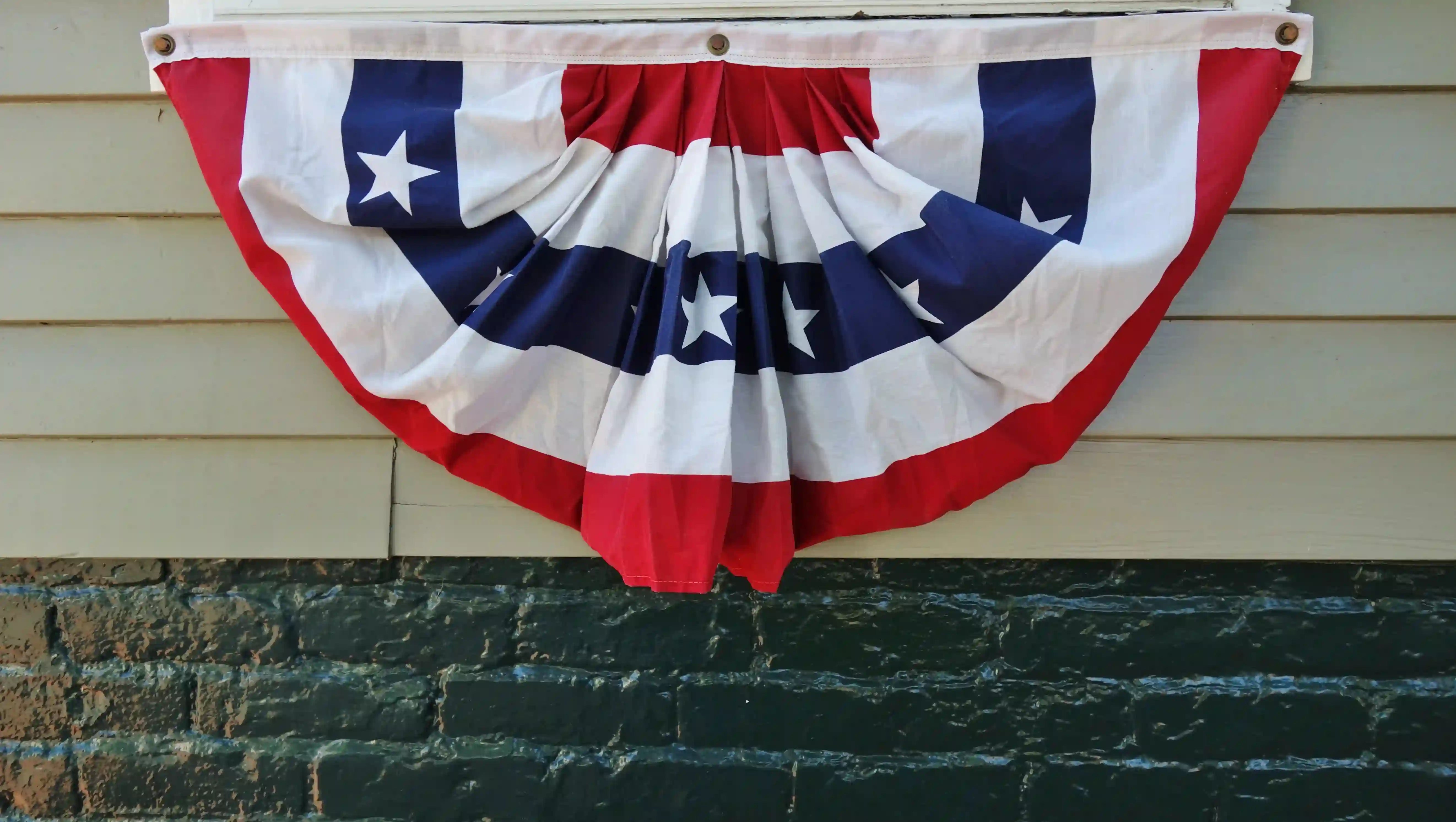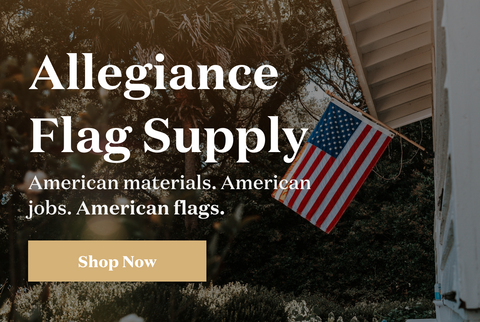Origins
Bunting technically refers to the lighter, looser woven fabrics that hang vertically over rope. Read below to learn more about these beautiful patriotic displays.
Flags have been around for a massive amount of time. Bunting flags have a unique history of their own. The word bunting itself has a mysterious origin, as we aren’t really sure how the word came to be. However, in the modern-day, we use it to describe a string of paper triangles or fabric, usually in decorative form.
The first time bunting was seemingly documented came around the seventeenth century when the British Naval Force decided to use bunting to mark their vessels. This method was preferred to indicate to other ships where their allegiance lay — either friendly or not depending on who they encountered on the open seas. Even today, the occupation of raising the flags aboard these ships is titled “the bunt” or “bunting tosser.”
United States Bunting
History
Before the Civil War, flagmakers in America used English-imported bunting to construct their domestic versions. General Benjamin F. Butler established the United States Bunting Company in March of 1865 under the wing of the Wamesit Power Company. It did not take long before the United States Bunting Company rose to prominence and became the best manufacturer of this material in the country.
Using his connections to the government, Butler incorporated his bunting into these contractual agreements within these realms of the economy as well. In 1866, his agent proposed the idea of the United States Bunting Company designing an American flag to be hoisted over the Capitol building that measured at 21 x 12 feet in total area. It went down as the first American Bunting Flag to be raised at this site in history.
Continued Success
By the 1870s, U.S. Bunting emerged as the second-largest wooden mill in Lowell, MA, and began dabbling their fingertips into the dress market as well. An appointed superintendent began running the company at this time by the name of Walter H. McDaniels. By the 1880s, they employed 450 people and operated five-card sets, 5,000 spindles, and 220 looms while using 3,000 pounds of wool per day.
Even today, the best United States flags are American-made.
Once the treasurer of the U.S. Bunting and agent of Butler, De Witt C. Farrington retired in 1893, McDaniels sought after two brothers to help fill the void carrying into the 20th century. The Stevens brothers continued to run this business until around the midway point of the century when they shut down U.S. Bunting in 1947. Despite the pioneer company ceasing to exist, bunting still is alive and well today.
How To Make Your Own Red, White and Blue Bunting
Beginning Steps
If you are interested in designing your own bunting, try following these steps on your own. You’re going to need a decent amount of materials before you begin your masterpiece.
You will require the need of a pencil, a large grommet kit (a toolbox that helps you create flag-like holes on fabrics), a hammer, needle, sewing machine, iron, and an ironing board. You’re also going to need twirl fabrics in red, white, and blue, as well as an all-purpose thread that matches these shades, as well as scissors, and finally, a yardstick.
After your materials are organized, begin the process by cutting your red fabric to seven inches by 30, your two white fabrics to 7 x 60 inches, and 2 x 40 inches. Finally, cut your two blue pieces of fabric to 7 x 55 inches.
When you’re finished with step one of the process, lay the pieces you’ve made into a semi-circle to roughly map out where they will align after you stitch them together. This helps visualize the fabrics you’ve cut out in their finished product so you can hopefully notice if you mismeasured something along the way.
Threading
The next step involves threading the red needle in pleats (double fold) at the top edge of your red fabric until your knot catches. After this, you want to fan out the red fabric and begin to pleat your white fabric to the opposite edge of your red.
Sew along this line while removing your pins along the way. It helps to fold your seam over so that the fabric edges are facing the same direction and pin your sides first and then focus on the center. After this is done, you want to pin the center of your white-edged fabric to the center of the bottom edge of your red stripe.
Finishing Touches
After this is complete, the next step is to sew and pin your blue stripe in the same manner as you did for the white one. Attach it below the white stripe following a similar pattern/process as before. Once you sew this with a sewing machine, begin pressing the hems on your other white strip of fabric.
Fold your 2 x 40-inch white header on top of your bunting using a hemmed edge, and then pin it into place. When sewing this part on, it’s usually too tough for machines to handle in the center portion, so do this part by hand.
Now that you have your bunting, the last thing you need to do is add grommets so that you can hang the bunting. Measure 1.5 inches from the outside edge of your header and cut a small hole. You want to cut four holes along this edge and hammer the eyelets into place. Once these are all set, your bunting will finally be complete!
Why American Bunting is Important
Meaning
Similar to the honor that goes into hoisting the Stars and Stripes, raising American-themed bunting is another way of appreciating the United States. It is commonly used on Independence Day as a way to show pride and boast the freedoms and individual rights that American citizens possess.
Displaying American bunting has a unique ability to bring people to unification around these Constitutional Rights on which the United States was initially founded upon.
Flags in the USA
Any source of red, white, and blue colors goes a long way on the Fourth of July. As all Americans know, the day we won our independence approximately 250 years ago brings joy to their hearts, and bunting symbolizes this with a festive touch.
If you don’t know if you’re up for the challenge of making red, white, and blue bunting, buy an American flag to show your patriotism instead. Here at Allegiance Flag Supply, we make the highest quality flags from the most talented seamstresses all here in the United States.
A Great Alternative
Practicality
Bunting is an alternate material used to construct flags of all sorts. This refers to the lighter-based fabric that goes into creating these banners, which tend to hang from a horizontal string that can be attached to any raised surface.
Bunting can be extremely convenient to those who might not own a flag pole but want to express some sort of flag/banner in their own way. It was originally used by Royal Navy vessels to display allegiance or danger to opposing ships on the water back in the 1700s. Even today, the navy title their flag bearers “the bunt” or “bunting tosser” over three centuries later.
Dating all the way back to the Civil War Era, American bunting (or U.S. Bunting) came from foreign British-made materials mended into similar designs that we know today. The first American-made bunting company was founded by a man named Benjamin F. Butler, who quickly turned this into the top manufacturer in the entire country.
American Bunting Past vs. Present
Butler was able to spread his products to realms of the government due to his connections from being a retired war general and was responsible for creating the first American bunting flag that was hoisted at the United States Capitol building in 1866.
His company went on to achieve continued success even after he passed away due to his excellent ability to hire trustworthy businesses to carry out his vision for almost 80 years. Despite the fact that his company was discontinued circa 1947, the American bunting product is still immensely popular today due to his noteworthy accomplishments.
Today in America, bunting is still used as an excellent way to express pride in the nation that freed itself from British tyranny centuries ago. It’s especially prevalent on Independence Day, as Americans all over the nation hang it on their doorways and window sills on display to boast the red, white and blue colors that are replicated on the Stars and Stripes.
Although bunting is a different way of boasting pride in the United States, it’s a fun, creative way to decorate for the holiday and appreciate the land of the free, the home of the brave.
Sources:
U.S. Bunting | Lowell and Trust





